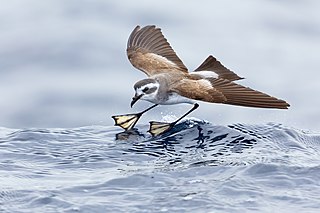
The white-faced storm petrel, also known as white-faced petrel is a small seabird of the austral storm petrel family Oceanitidae. It is the only member of the monotypic genus Pelagodroma.
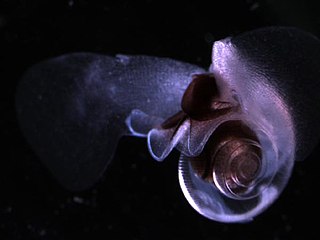
The Limacinidae are a family of small sea snails, pteropods, pelagic marine gastropod mollusks in the clade Thecosomata.

Arripis is a genus of marine fishes from Australia and New Zealand, known as Australian salmon, kahawai and Australian herring. They are the only members of the family Arripidae. Despite the common name, Australian salmon are not related to the salmon family Salmonidae of the Northern Hemisphere, just as Australian herring are not related to herring of the Northern Hemisphere, but belong to the order Perciformes of perch-like fishes. Australian salmon were named so by early European settlers after their superficial resemblance to the salmoniform fishes.

Pelagic fish live in the pelagic zone of ocean or lake waters—being neither close to the bottom nor near the shore—in contrast with demersal fish that live on or near the bottom, and reef fish that are associated with coral reefs.

Glaucus atlanticus is a species of small, blue sea slug, a pelagic (open-ocean) aeolid nudibranch, a shell-less gastropod mollusk in the family Glaucidae.

The common thresher, also known as Atlantic thresher, is the largest species of thresher shark, family Alopiidae, reaching some 6 m (20 ft) in length. About half of its length consists of the elongated upper lobe of its caudal fin. With a streamlined body, short pointed snout, and modestly sized eyes, the common thresher resembles the pelagic thresher. It can be distinguished from the latter species by the white of its belly extending in a band over the bases of its pectoral fins. The common thresher is distributed worldwide in tropical and temperate waters, though it prefers cooler temperatures. It can be found both close to shore and in the open ocean, from the surface to a depth of 550 m (1,800 ft). It is seasonally migratory and spends summers at lower latitudes.
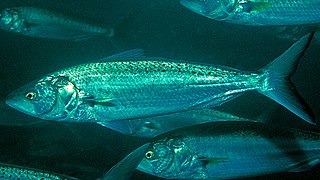
Arripis trutta, known as the Australian salmon in Australia and as kahawai in New Zealand, is a South Pacific marine fish and one of the four extant species within the genus Arripis, native to the cooler waters around the southeastern Australian coasts and the New Zealand coastline. Other common names for this species include Eastern Australian salmon, bay trout, blackback salmon, buck salmon, cocky salmon, colonial salmon, newfish and salmon trout.
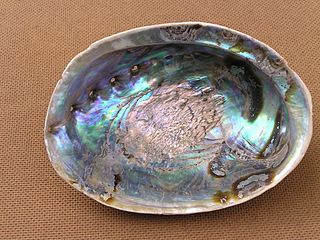
Pāua is the Māori name given to three New Zealand species of large edible sea snails, marine gastropod molluscs which belong to the family Haliotidae, known in the United States and Australia as abalone, and in the United Kingdom as ormer shells. Pāua has entered English through common use in the New Zealand English dialect, and is both singular and plural, following the grammar rules of its original language.

Carinariidae, known by the common name "heteropods" like their relatives in the Pterotracheoidea, is a taxonomic family of swimming or floating sea snails, pelagic marine gastropod molluscs in the clade Littorinimorpha.

Carinaria is a genus of medium-sized floating sea snails, pelagic gastropod molluscs in the family Carinariidae.
Cardiapoda is a genus of very small floating sea snails or heteropods, pelagic gastropod molluscs or micromolluscs in the family Carinariidae.
Cardiapoda placenta, common name the flat cardiapod, is a species of sea snail, a rare pelagic gastropod mollusc in the family Carinariidae.

Pterotracheidae is a family of medium-sized to large floating sea snails, pelagic gastropod molluscs. They are in the superfamily Pterotracheoidea along with two other similar pelagic families, the Atlantidae and the Carinariidae.

Pterotrachea coronata is a species of large floating sea snail, a pelagic gastropod mollusc in the family Pterotracheidae.

Phylliroe is a genus of average sized, highly transparent pelagic nudibranchs, marine gastropod molluscs in the order Opisthobranchia, that consists of two known species. It is notable for being an open-ocean hunter that resembles a fish in body plan and locomotion, an example of convergent evolution.

Phylliroe bucephala is a parasitic species of pelagic nudibranch, a marine gastropod mollusc in the family Phylliroidae.
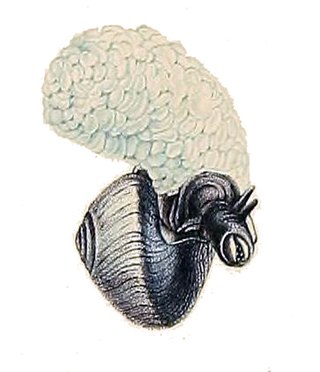
Janthina janthina is a species of holoplanktonic sea snail, a marine gastropod mollusk in the family Epitoniidae. Its common names include violet sea-snail, common violet snail, large violet snail and purple storm snail.

The Pterotracheoidea is, according to the Taxonomy of the Gastropoda, a taxonomic superfamily of sea snails or sea slugs, marine gastropod molluscs in the clade Littorinimorpha. They are commonly called heteropods or sea elephants.

Cymbulioidea is a taxonomic superfamily of pelagic "sea butterflies", one group of swimming sea snails. They are holoplanktonic opisthobranch gastropod molluscs in the clade Thecosomata.
Cephalopyge trematoides is a pelagic species of nudibranch. A free-swimming marine gastropod in the family Phylliroidae. Cephalopyge trematoides is the only known species in its genus.














